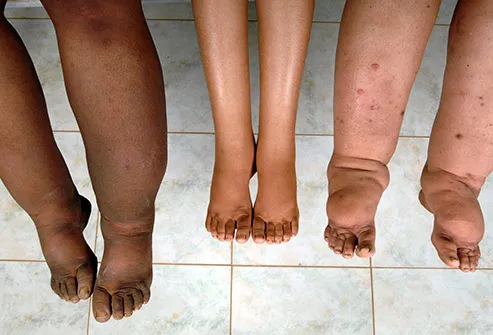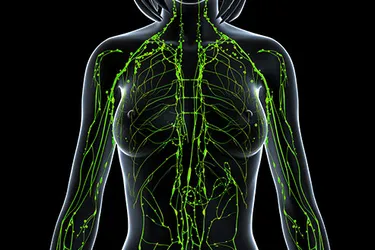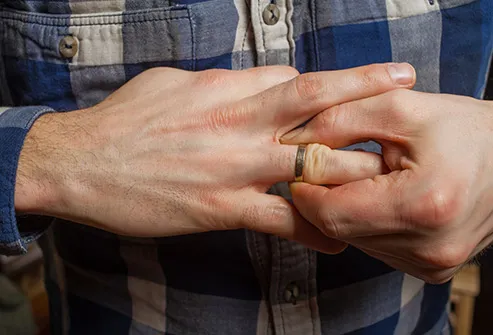A Visual Guide to Lymphedema

1/13
What Is It?
In a word, swelling. Extra fluid builds up in your tissue when your lymphatic system isn't working well, usually because your lymph nodes were damaged or removed. It's often a side effect of cancer treatment and can show up years later.

2/13
What Happens
The lymphatic system is part of your immune system. It moves fluid through your body, picking up waste, bacteria, and viruses. Your lymph nodes filter out the waste and flush it from your body. When something goes wrong, the fluid backs up in your tissue. Most often, your lymph nodes got damaged. Sometimes the vessels get blocked. But lymphedema can also happen without a clear reason.

3/13
Symptoms
It can happen anywhere in your body, including your chest, head, and genitals, but it's usually in just one arm or leg. The swelling might be so minor that you barely notice, or so severe it makes it hard to move that part of your body well. A limb that feels full or heavy, skin that seems tight, and jewelry and clothes that are suddenly snug can be from lymphedema. You could be achy or have hardened skin in the affected area.

4/13
Who Is Likely to Get It?
Many people with it had surgery to remove lymph nodes to check for the spread of breast cancer, or treated their cancer with surgery or radiation. Being older, overweight, or having rheumatoid or psoriatic arthritis raises your chances. You could also get it from an infection while traveling in certain tropical countries. Rare disorders passed in families can affect the development of the nodes and vessels in the lymph system, too.

5/13
Prevention
After surgery or radiation involving your lymph nodes, keep the affected arm or leg above your heart. Don't apply ice or heat to it. Skip tight clothing and jewelry. Don't cross your legs while sitting.
If swelling starts or you get other symptoms, let your doctor know. Early treatment of lymphedema makes a difference.

6/13
Diagnosis
Your doctor will rule out other causes of swelling, such as infections and blood clots. He'll measure the swollen area and compare it with a similar unaffected one. Tests that check for blockages and see how your lymphatic system is working include MRI and lymphoscintigraphy, which follows special dye injected into your body as it moves through the lymph vessels. Grades (1-4) or stages (I-III) describe how severe lymphedema is.

7/13
Treatment
Lymphedema can't be cured, but you can control the swelling and keep it from getting worse. Getting to and staying at a healthy weight may make it better, but "water pills" usually won't. Specialized lymphedema therapists can also help you manage the condition. If it's severe, your doctor may want to do surgery to remove some tissue so there's less swelling. Stage I may go away without treatment.

8/13
Bandages
Wrap them tightest near your fingers and toes and looser along your limb so fluid flows toward your torso. The pressure also stops fluid from building up again once the swelling has gone down. A therapist can show you how to arrange the layers of liners, padding, and bandages.

9/13
Exercise
Gentle movements that squeeze the muscles in your affected limb can help fluid drain and make it easier to do everyday things. Activities that get your heart pumping and make you breathe a little harder can also bring down the swelling. Talk to a lymphedema specialist about what's best for you.

10/13
Compression Garments
A special cloth sleeve or stocking puts pressure on your arm or leg to help fluid move through and out of your swollen limb. Make sure to wear it when you exercise and when you travel by plane, since sky-high altitude can make lymphedema worse. You may need a prescription to get one with the right fit.

11/13
Massage Therapy
We're not talking about your standard spa service. This special, light-handed type of massage is called manual lymph drainage. A trained professional rubs, taps, and strokes your body to try to move fluid away from the swollen area. You can learn to do it yourself, too.

12/13
Compression Device
A trained therapist can use a machine kind of like a blood pressure cuff to help move lymph fluid out of your arm or leg. They'll put a sleeve or boot with a series of chambers over the swollen area. A pump fills the pockets with air and then deflates them over and over in a specific pattern to squeeze the lymph back toward your body.

13/13
Avoid Infections
Take care to prevent cuts, scratches, and burns to the affected area. Have shots and blood draws done elsewhere. Those tiny injuries can be entry points for infections. The trapped fluid in your tissue will allow bacteria to grow, and it can quickly become serious. Call your doctor if you get red skin or a rash, you have flu-like symptoms, or the pain or swelling gets worse.
- Obtener vínculo
- X
- Correo electrónico
- Otras apps
Comentarios